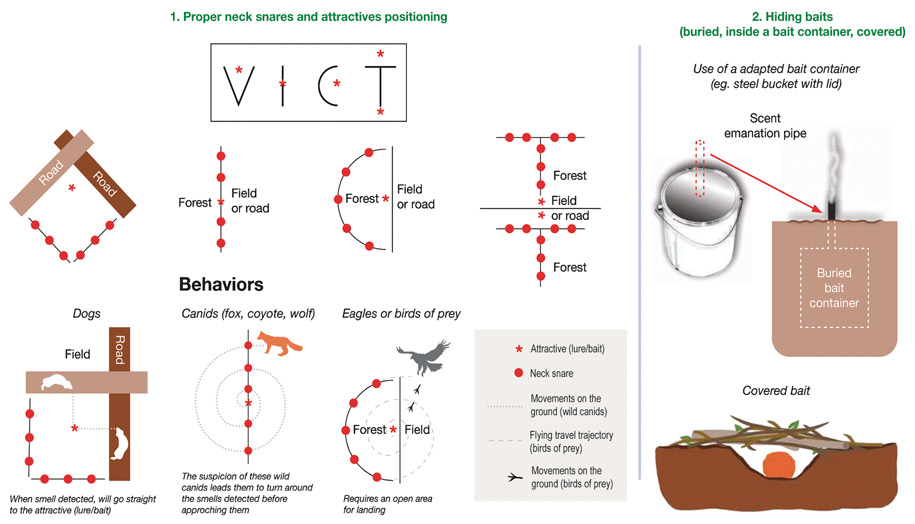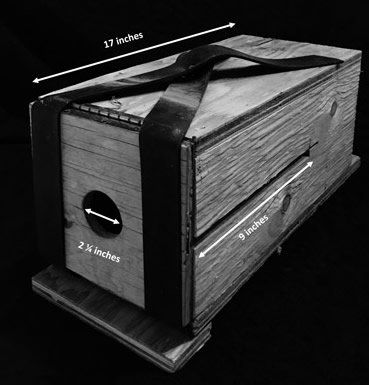Best Trapping Practices
The illustrations and data provided below were inspired from the results of the trap testing completed through the work of the Trap Research and Development Committee of the Fur Institute of Canada. They are intended as general guidelines for trap users.
Illustrations © Fédération des Trappeurs Gestionnaires du Québec, Fur Institute of Canada and Ministère des Forêts, de la Faune et Parcs (Quebec).
RECOMMENDED DESIGN AND COMPONENTS – KILLING NECK SNARES

RECOMMENDED PARTS – KILLING NECK SNARES

SETTING PRINCIPLES – KILLING NECK SNARES

GENERAL SET GUIDELINES (DOG, EAGLES, BIRDS OF PREY) – SOLUTIONS

ACCIDENTAL CATCHES (cervidae, cattle, sheep)

ACCIDENTAL CATCHES (eagles and birds of prey)

Fisher Exclusion Box
FISHER
All fishers trapped during an open season must be registered (see Mandatory Registration), including those fishers incidentally trapped in areas or at times with no open season.
To minimize incidental capture of fisher in marginal areas and to maintain or enhance fisher populations where marten trapping is taking place, marten boxes can be modified by making them longer and the entry hole ≤2¼” in diameter (see diagram at right). Using this method, fishers are deterred from entering the marten box.
Marten box at right modified with fisher exclusion plate. The exclusion plate splits horizontally in the hole middle and is held in place by thick rubber straps to allow for the extraction of an animal.

Buffer Zones for Pet Protection
To prevent the accidental trapping of pets, trappers should avoid setting snares, lures, or bait within 200 metres of property lines where they lack trapping permission. This best practice helps ensure the safety of neighbouring pets, particularly dogs, from unintended harm.

Trapping in Protected Areas
In certain cases trapping is allowed within specific protected areas where this activity is not normally allowed. This may involve a Provincial Park or Recreation Area (or portions of such areas) that fall within an RFMA. If trapping is allowed in such an area individuals who wish to trap on those portions of the RFMA may be required to obtain a Firearms Carry and Discharge Permit from Alberta Parks. Please contact your local Alberta Parks Office to confirm if trapping is allowed in a protected area and if this permit is required.
Accidental Trapping
Trappers who accidentally trap a furbearing animal during a closed season or who trap a big game animal or bird of prey are required to submit to Fish and Wildlife a completed report and, in the case of a furbearing animal, bear or cougar, deliver it to a Fish and Wildlife District Office no later than 14 days after the date of capture. Such animals do not have to be skinned.
Swift Fox has been reintroduced into Fur Management Zone 8, and trappers are encouraged to take all reasonable care to prevent accidental capture, and to report any contact with this species. Injured Swift Fox should be immediately delivered to the nearest Fish & Wildlife District Office, or a qualified veterinarian for care.
Trappers who accidentally capture any wildlife that are not furbearing animals are reminded to report the incident as soon as practical to the nearest Fish & Wildlife District Office. In addition, permission must first be obtained from Alberta Forestry and Parks to use such an animal as bait.
Diseases
Diseases and parasites are normal parts of the life of a furbearer. Usually, they are not a problem either for the furbearer or for the person trapping an infected animal. Indeed, most parasites and diseases go completely unnoticed by trappers. However, there are situations where an animal may be infected with a disease that can be transferred to people. Such diseases are most often caused by bacteria and can be recognized readily by the presence of small white spots in the liver and spleen of an infected furbearer. Such animals should be handled carefully (preferably with gloves on). Any person who handles wildlife and then has persistent “flu-like” symptoms or redness, swelling, heat or pain in hands or arms should contact a medical doctor. Remember to tell the doctor the person has handled wildlife.
Carcasses from all furbearers suspected of being diseased should be submitted for examination to the nearest Fish & Wildlife District Office.
Wild canids in Alberta could contain tiny tapeworms in the intestines. Eggs of these tapeworms can potentially infect people. Thus, trappers and field biologists should wear gloves when handling or processing wolves, coyotes, foxes, or their scats and thoroughly clean knives and work tables when done. Particular care should be taken when skinning around the anus or when carcasses are soiled with faecal material. In addition, do not feed internal organs of moose or elk to dogs – the dogs could become infected and pass on tapeworm eggs to people. Regular de-worming of dogs also reduces potential risk to humans.
There are two different Echinococcus species that could occur in wild canids. See https://open.alberta.ca/publications/0778535959 and https://open.alberta.ca/publications/echinococcus-multilocularis-in-alberta for more information.
Community Relations
To foster and maintain good relations within their communities and to gain public support, trappers should:
Alberta Trappers' Compensation Program
The Alberta Trappers’ Compensation Program provides a framework for compensating Senior RFMA holders for business losses incurred through industrial activity on their RFMAs, when they are unable to reach a settlement with industry. Incidences of theft or vandalism to assets on RFMAs will also be considered.
Only Senior Registered Fur Management Licence holders are eligible to submit a claim for consideration, and claimants must be considered active trappers, as defined by Alberta Forestry and Parks, and must demonstrate failed efforts to resolve their dispute directly with industry.
Claims are reviewed by a board of directors, consisting of government, Industry and trapping community stakeholders, with subsequent direction given to the Alberta Trappers Association, who administers the Alberta Trapper Compensation Program through a Memorandum of Understanding with Alberta Forestry and Parks
Claim types considered by the ATCP include:
In all cases where compensation is considered, fur value shall be based upon the average selling price of raw furs as provided in the annual Alberta Guide to Trapping Regulations. Cabins lost to naturally caused forest fires (funded by trappers).
For claims related to the damaged asset and temporary disruption categories, the trapper must first negotiate directly with the company responsible. Should this action fail, the claim must be submitted to the Alberta Trappers Compensation Board to receive consideration. All theft and vandalism must be promptly reported to the RCMP.
Requests for compensation must be made on the approved ATCP Claim Form available on the ATA website (albertatrappers.com), and include any attachments relevant to the claim. This may include:
Trappers must cooperate with industry to ensure the success of the program. If you have any questions about this program, please contact a Fish and Wildlife District Office or the Alberta Trappers Association, Box 6020, Westlock, Alberta T7P 2P7 (780-349-6626).

Five operational committees develop programs and deliver project activities within the structure of the Institute. These programs are trap research and development, communications, sealing, aboriginal communications and international relations and conservation.
The Fur Institute of Canada is committed to delivering information to the media, the general public and governments pertaining to the economic, social, cultural and environmental contributions made by today’s fur trade.
For further information, contact the Fur Institute of Canada
Trappers should be prepared to release non-target animals that are not seriously injured. Carefully assess the risk factors involved in releasing an animal or bird to ensure personal safety and the welfare of the animal or bird.
Methods of releasing animals include:
Using a forked stick

Using a snare pole
![]()
Using a tarp, coat or blanket
| Trappers who accidentally capture any wildlife that are not furbearing animals are reminded to report the incident as soon as practical to the nearest Fish and Wildlife District Office. Accidental capture of Birds of Prey, i.e. Eagles, or Endangered Species such as Swift Fox that cannot be readily released due to injury should be delivered to the nearest Fish and Wildlife District Office or a qualified veterinarian for care. |
| Home | Changes and Definitions | General Regulations | Licensing and Costs | Quotas and Fur Seasons | Fur-bearer Management | Additional Information | WMU & Map Descriptions | Fish and Wildlife Offices |